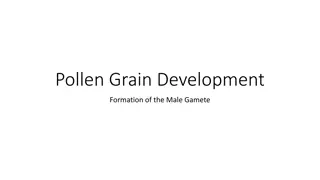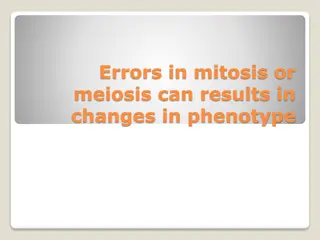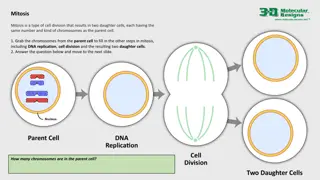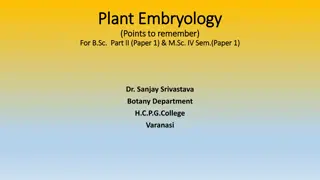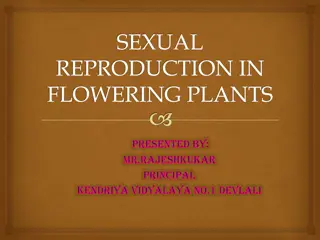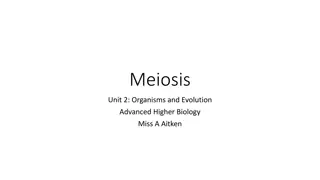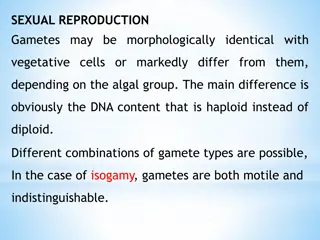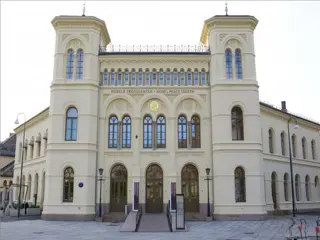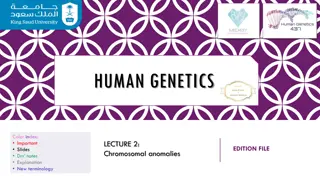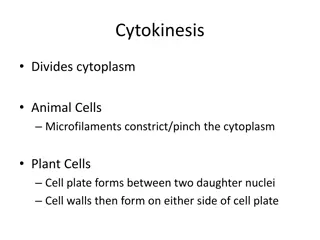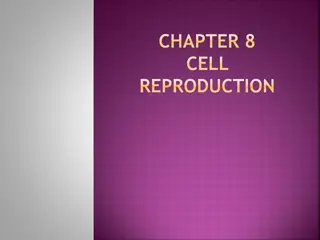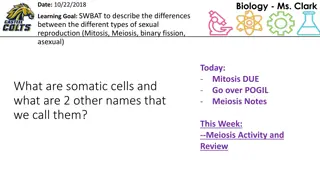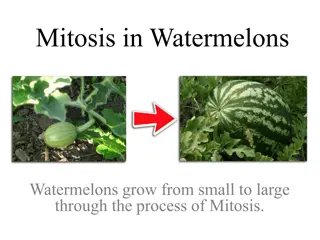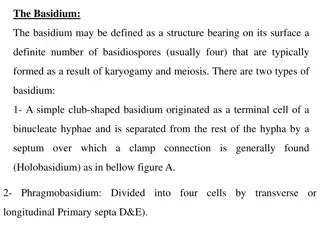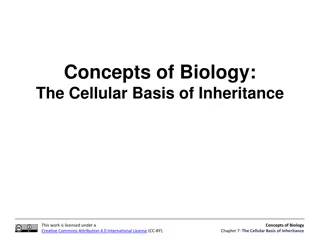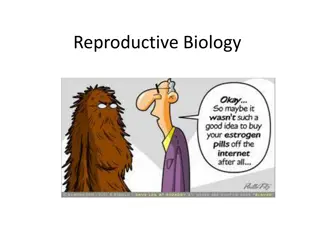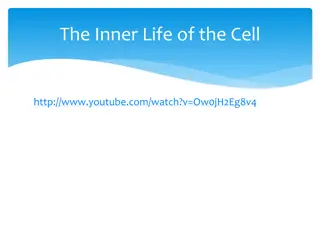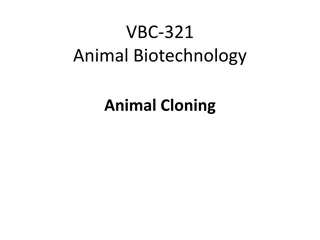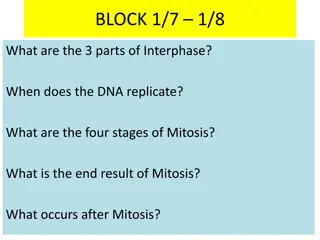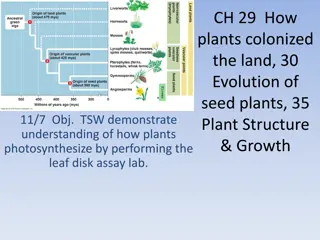Pollen Grain Development
The process of pollen grain development and formation of the male gamete involves crucial stages such as the presence of diploid microspore mother cells in the stamen, meiosis resulting in the formation of four haploid cells and tetrads, mitosis leading to the development of two haploid nuclei in ea
0 views • 6 slides
Chromosomal Alterations and Their Impact on Phenotype
Errors in mitosis or meiosis can result in changes in phenotype, often due to alterations in chromosome structure such as deletion, duplication, inversion, and translocation. Nondisjunction can lead to abnormal chromosome number, resulting in disorders like aneuploidy. Polyploidy, with extra complet
0 views • 9 slides
Cell Division Processes: Mitosis and Meiosis Explained
Mitosis and meiosis are two types of cell division processes with distinct outcomes in terms of chromosome numbers. Mitosis results in two daughter cells with the same number of chromosomes as the parent cell, while meiosis produces four gamete cells with half the chromosome number. This explanation
2 views • 5 slides
Insights into Plant Embryology: Points to Remember for Botany Students
Explore key points in plant embryology including terminology, structure of anthers, pollen grain formation, pollen viability testing, and aspects of meiosis. Understand the significant contributions of Prof. Panchanan Maheshwari to Indian plant embryology.
0 views • 11 slides
Understanding Sexual Reproduction in Flowering Plants
Explore the fascinating process of sexual reproduction in flowering plants, presented by Mr. Rajeshkukar, Principal of Kendriya Vidyalaya No. 1 Devlali. Discover the parts of a flower, including the androecium and gynoecium, stamen, anther structure, and microsporogenesis. Dive into the intricate de
8 views • 35 slides
Understanding Meiosis: Key Concepts in Biological Evolution
Meiosis is a crucial process in organisms, involving the formation of haploid gametes with unique allele combinations. This process ensures genetic diversity through crossing over and independent assortment, leading to variations essential for evolution. The significance of homologous chromosomes, d
1 views • 22 slides
Understanding Algal Sexual Reproduction and Life Cycles
Algal sexual reproduction involves various types of gametes, from isogamy to oogamy, with distinct sizes and motility. Algae exhibit different life cycles like haplontic, diplontic, and diplohaplontic, each characterized by specific mechanisms of meiosis and stages of haploid and diploid phases.
0 views • 24 slides
Biology Power Standards Learning Targets and Essential Questions
This educational material covers Biology Power Standards related to DNA structure, protein synthesis, genetic variations, meiosis, mutations, and natural selection. Essential questions are provided for each standard, focused on topics like mRNA, DNA duplication, enzyme polymerase, and the relationsh
0 views • 13 slides
Understanding Meiosis: The Key Processes and Concepts
Meiosis is a crucial process in genetics where the number of chromosomes is halved through two divisions, resulting in the formation of haploid cells from diploid cells. This process involves key concepts such as homologous chromosomes, crossing over, alleles, and the distinction between diploid and
0 views • 22 slides
Understanding Chromosomes: Key Components, Functions, and Significance
Chromosomes, essential in mitosis and meiosis, are condensed forms of DNA vital for heredity, mutation, and evolution. Learn about their structure, role in inheritance, and impact on species development through historical discoveries. Discover the importance of chromosome sets and genomes in gametic
0 views • 38 slides
Understanding Chromosomal Abnormalities and Syndromes
Human cells have 22 pairs of autosomes and one pair of sex chromosomes, totaling 46. Karyotypes help diagnose chromosomal abnormalities by aligning chromosomes in size order. Nondisjunction during meiosis can lead to abnormal chromosome numbers in gametes. Disorders like Down Syndrome, XYY Syndrome,
0 views • 30 slides
Understanding Chromosomal Anomalies in Human Genetics
This lecture covers essential topics in human genetics, focusing on mitosis, meiosis, and chromosomal abnormalities. Students will learn about the events in mitosis and meiosis, non-disjunction, and classification of chromosomal anomalies, including numerical and structural abnormalities. Detailed e
1 views • 22 slides
Biology Review: Genetics, Enzymes, and Cell Division
Explore key concepts in AP Biology, including genetic continuity and change, enzyme catalysis, mitosis, and meiosis. Understand the mechanisms of genetic variability and cell division processes. Dive into enzyme-substrate interactions and the differences between mitosis and meiosis.
0 views • 11 slides
Understanding Meiosis: Vocabulary, Notes, and Key Similarities with Mitosis
Explore the vocabulary and key concepts related to meiosis, including terms like homologous chromosomes, diploid, and haploid. Learn about the process of meiosis, its stages, and the similarities and differences between meiosis and mitosis. Check your understanding of chromosome numbers and crossing
0 views • 21 slides
Understanding Meiosis and Genetic Variation in Organisms
Meiosis forms variable gametes in organisms, leading to increased genetic variation through the production of haploid gametes by meiosis I and II. Key concepts include homologous chromosomes, crossing over, independent assortment, and linked genes. Terminology such as homologous pairs and human chro
0 views • 29 slides
Understanding the Cell Cycle and Mitosis Process
The cell cycle consists of two main periods: Interphase and Mitosis. During Interphase, the cell prepares for division by growing in size and copying chromosomes. Mitosis, the division of the nucleus, results in the formation of two daughter cells with identical chromosome copies. Centrioles and cen
0 views • 26 slides
Cell Cycle Checkpoints and Meiosis Overview
Cell cycle regulation involves checkpoints at key stages like G1/S, G2/M, and M to ensure proper progression or halt if needed. Cancer cells disrupt this control, leading to uncontrolled proliferation. Meiosis involves two successive divisions, resulting in the reduction of chromosome number and gen
0 views • 27 slides
Understanding Meiotic Cell Division and Sexual Reproduction in General Biology
Meiosis is a crucial process in sexually reproducing organisms where cells divide to produce sex cells with half the normal number of chromosomes. This ensures genetic variation in offspring. Meiosis takes place in specific cells of an organism with paired chromosomes (diploid cells), leading to the
0 views • 18 slides
Understanding Cell Division: Processes and Types
Cell division is a vital process in living cells for growth and reproduction. This article explores the basics of cell division, including the cell cycle, types of cell division (such as mitosis and meiosis), and the initiation of cell division. It also covers key phases like interphase and provides
0 views • 20 slides
Overview of Cell Division Processes: Mitosis and Meiosis
Cell division involves two main processes: mitosis and meiosis. Mitosis is responsible for the division of somatic cells, producing identical daughter cells. It consists of prophase, metaphase, anaphase, and telophase, followed by cytokinesis. In contrast, meiosis is crucial for the formation of gam
4 views • 37 slides
Understanding Cell Reproduction: Chromosomes, Cell Cycle, and Division
Explore the fascinating world of cell reproduction, from the structure of chromosomes and the role of histones to the process of mitosis and meiosis. Learn about diploid and haploid cells, the significance of homologous chromosomes, and the stages of the cell cycle. Discover how different types of c
0 views • 14 slides
Understanding Gametogenesis and Oogenesis Process in Humans
Gametogenesis is the formation of gametes from germ cells in the testes and ovaries, involving meiosis and cytodifferentiation. Oogenesis specifically refers to the differentiation of oogonia into mature oocytes, with prenatal oogenesis occurring before birth and postnatal oogenesis after birth. The
0 views • 17 slides
Understanding Mosaicism: Types, Causes, and Implications in Genetics
Mosaicism is the presence of genetically different cell lines within one individual, often involving sex chromosomes due to mitotic defects in early development. Chromosomal mosaicism can be distinguished from chimerism, and its association with gametogenesis and aneuploidy is influenced by maternal
0 views • 17 slides
Biology Class Learning Goals and Activities with Ms. Clark
Ms. Clark's biology class focuses on understanding the differences between types of sexual reproduction such as mitosis, meiosis, binary fission, and asexual reproduction. Students learn about somatic cells, genetic variation in meiosis, DNA, genes, and chromosomes. Activities include notes, videos,
0 views • 4 slides
Genetics and Meiosis Pretest Questions
This content provides a series of pretest questions related to genetics, protein synthesis, meiosis, and related concepts. It includes multiple-choice questions covering topics such as protein synthesis processes, types of mutations, meiosis divisions, genetic recombination, and more.
0 views • 37 slides
The Process of Mitosis and Meiosis in Watermelons
Watermelons undergo the processes of mitosis and meiosis to grow and reproduce. During mitosis, watermelons develop through interphase, prophase, metaphase, anaphase, and telophase. In meiosis, seeded watermelons produce gametes through prophase I, metaphase I, anaphase I, and telophase I. Both proc
0 views • 16 slides
Understanding Basidium: Structure and Classification of Basidiomycetes
The basidium is a key structure in fungi bearing basidiospores formed through karyogamy and meiosis. Basidiomycetes are classified into sub classes based on basidium types such as Heterobasidiomycetidae and Homobasidiomycetidae. Uredinales and Ustilaginales are orders of basidiomycetes involving rus
0 views • 6 slides
The Cellular Basis of Inheritance in Biology
Understanding the significance of meiosis and sexual reproduction, this chapter delves into how multicellular organisms develop from a single fertilized egg through trillions of cell divisions. Exploring the necessity for genetic variation and the difference in reproductive strategies among organism
0 views • 29 slides
Development of Female Gamete and Embryo Sac in Plant Reproduction
In plant reproduction, the formation of female gametes involves meiosis in cells of the carpel sac, leading to the development of the embryo sac or megaspore. Meiosis results in four haploid cells, of which three degenerate, and one survives. This surviving cell undergoes multiple rounds of mitosis,
0 views • 7 slides
Understanding Ecology and Biodiversity
Ecology explores the dynamic interactions between living (biotic) and non-living (abiotic) factors in ecosystems. It delves into selective breeding, protein structure, hormones, placenta function, and the vulnerability of embryos during early development. Meiosis, mRNA translation, feedback mechanis
0 views • 25 slides
Understanding Male Reproductive Anatomy and Function
Explore the intricate male reproductive system from meiosis to accessory glands, learning about the purpose and location of processes like meiosis, sperm production in the testes, and the functions of structures such as the epididymis, vas deferens, urethra, and accessory glands in semen production
2 views • 23 slides
A Comprehensive Comparison of Mitosis, Meiosis, and Cellular Processes in Cells
Explore the intricate processes of mitosis and meiosis, delving into how cells divide and reproduce, as well as the vital functions of cellular respiration and photosynthesis. Learn about DNA, chromosomes, and the phases of mitosis. Discover the key differences between mitosis and meiosis in cell di
0 views • 22 slides
Applications of Transgenic Animals in Biotechnology and Cloning
Cloning in animals offers the advantage of indefinite duplication of elite genotypes without the genetic risks of meiosis. Transgenic animals, genetically modified to carry foreign genes, play a crucial role in genetic research and the development of livestock with desired traits. Methods like DNA m
0 views • 13 slides
Genetics and Cell Division Study Guide
Explore topics ranging from cell division phases, mitosis stages, genetic variation in sexual reproduction, chromosome structures, karyotypes, Mendel's laws, Punnett squares, and more in this comprehensive study guide. Understand key concepts such as DNA replication, chromosomal abnormalities, gamet
0 views • 46 slides
Understanding Plant Evolution and Characteristics
Plants colonized land through various adaptations such as multicellularity and photosynthesis. They exhibit characteristics like chlorophyll, cellulose cell walls, and apical meristems. Plant evolution includes alternation of generations, with gametophytes and sporophytes undergoing meiosis and mito
0 views • 15 slides
Understanding Genetics: Concepts of Heredity, Mitosis, Meiosis, and DNA
Genetics is the study of heredity and genetic variations, involving terms like genotype, phenotype, homozygous, heterozygous, dominant, and recessive. Mitosis and meiosis are key processes in cell division, each with specific phases and functions. DNA, or Deoxyribonucleic Acid, stores and transmits
0 views • 14 slides
